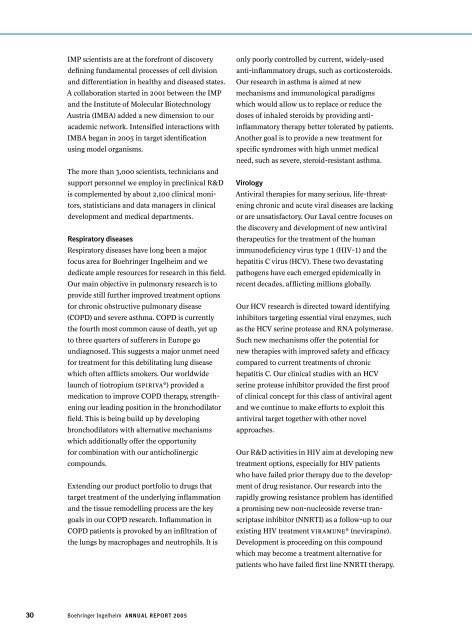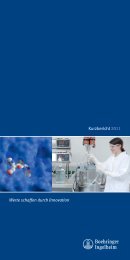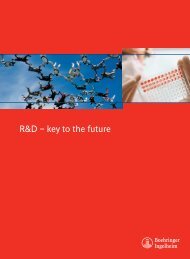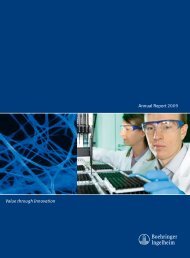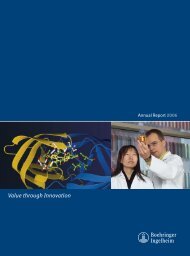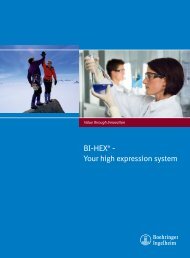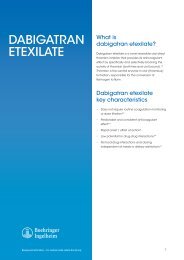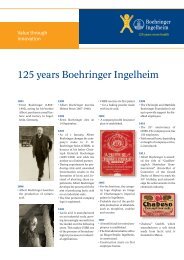Annual Report 2005 - Boehringer Ingelheim
Annual Report 2005 - Boehringer Ingelheim
Annual Report 2005 - Boehringer Ingelheim
Create successful ePaper yourself
Turn your PDF publications into a flip-book with our unique Google optimized e-Paper software.
0<br />
IMP scientists are at the forefront of discovery<br />
defining fundamental processes of cell division<br />
and differentiation in healthy and diseased states.<br />
A collaboration started in 2001 between the IMP<br />
and the Institute of Molecular Biotechnology<br />
Austria (IMBA) added a new dimension to our<br />
academic network. Intensified interactions with<br />
IMBA began in <strong>2005</strong> in target identification<br />
using model organisms.<br />
The more than 3,000 scientists, technicians and<br />
support personnel we employ in preclinical R&D<br />
is complemented by about 2,100 clinical moni-<br />
tors, statisticians and data managers in clinical<br />
development and medical departments.<br />
Respiratory diseases<br />
Respiratory diseases have long been a major<br />
focus area for <strong>Boehringer</strong> <strong>Ingelheim</strong> and we<br />
dedicate ample resources for research in this field.<br />
Our main objective in pulmonary research is to<br />
provide still further improved treatment options<br />
for chronic obstructive pulmonary disease<br />
(COPD) and severe asthma. COPD is currently<br />
the fourth most common cause of death, yet up<br />
to three quarters of sufferers in Europe go<br />
undiagnosed. This suggests a major unmet need<br />
for treatment for this debilitating lung disease<br />
which often afflicts smokers. Our worldwide<br />
launch of tiotropium (spiriva®) provided a<br />
medication to improve COPD therapy, strength-<br />
ening our leading position in the bronchodilator<br />
field. This is being build up by developing<br />
bronchodilators with alternative mechanisms<br />
which additionally offer the opportunity<br />
for combination with our anticholinergic<br />
compounds.<br />
Extending our product portfolio to drugs that<br />
target treatment of the underlying inflammation<br />
and the tissue remodelling process are the key<br />
goals in our COPD research. Inflammation in<br />
COPD patients is provoked by an infiltration of<br />
the lungs by macrophages and neutrophils. It is<br />
<strong>Boehringer</strong> <strong>Ingelheim</strong> A n n u A l R e p o R t 2 0 0 5<br />
only poorly controlled by current, widely-used<br />
anti-inflammatory drugs, such as corticosteroids.<br />
Our research in asthma is aimed at new<br />
mechanisms and immunological paradigms<br />
which would allow us to replace or reduce the<br />
doses of inhaled steroids by providing anti-<br />
inflammatory therapy better tolerated by patients.<br />
Another goal is to provide a new treatment for<br />
specific syndromes with high unmet medical<br />
need, such as severe, steroid-resistant asthma.<br />
virology<br />
Antiviral therapies for many serious, life-threat-<br />
ening chronic and acute viral diseases are lacking<br />
or are unsatisfactory. Our Laval centre focuses on<br />
the discovery and development of new antiviral<br />
therapeutics for the treatment of the human<br />
immunodeficiency virus type 1 (HIV-1) and the<br />
hepatitis C virus (HCV). These two devastating<br />
pathogens have each emerged epidemically in<br />
recent decades, afflicting millions globally.<br />
Our HCV research is directed toward identifying<br />
inhibitors targeting essential viral enzymes, such<br />
as the HCV serine protease and RNA polymerase.<br />
Such new mechanisms offer the potential for<br />
new therapies with improved safety and efficacy<br />
compared to current treatments of chronic<br />
hepatitis C. Our clinical studies with an HCV<br />
serine protease inhibitor provided the first proof<br />
of clinical concept for this class of antiviral agent<br />
and we continue to make efforts to exploit this<br />
antiviral target together with other novel<br />
approaches.<br />
Our R&D activities in HIV aim at developing new<br />
treatment options, especially for HIV patients<br />
who have failed prior therapy due to the develop-<br />
ment of drug resistance. Our research into the<br />
rapidly growing resistance problem has identified<br />
a promising new non-nucleoside reverse tran-<br />
scriptase inhibitor (NNRTI) as a follow-up to our<br />
existing HIV treatment viramune® (nevirapine).<br />
Development is proceeding on this compound<br />
which may become a treatment alternative for<br />
patients who have failed first line NNRTI therapy.


